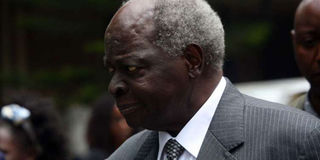Reflecting on President Kibaki’s Kenya in East Africa

Former President Mwai Kibaki at Consolata Shrine in Nairobi on September 25, 2016. PHOTO | EVANS HABIL | NATION MEDIA GROUP
What you need to know:
Kibaki was the first regional leader of the past 20 years to have an East African doctrine (beliefs).
It was much like Google’s: do no harm.
He did not publicly criticise other leaders or countries in the region and his Kenya did not compete against other East Africans for jobs in international bodies.
It enabled them.
Former Kenyan President Mwai Kibaki celebrated his 85th birthday on Tuesday. It is, therefore, a good time to go back to 2003, the early days when Kibaki had just been elected.
He was rather an odd man in the East African political context. He was 72. He was the least colourful leader in the region, yet he had become the first opposition candidate to win power at the polls from an incumbent party in eastern Africa.
In Uganda, President Yoweri Museveni was still youthful and riding high. He was still two years away from amending the constitution to remove term limits and open the door to being president for life.
In Rwanda, an even much younger Paul Kagame had formally become president. In Ethiopia Meles Zenawi was on the way to being a global African star. Tanzania’s President Ben Mkapa had donned the hat of the regional sage and was a favourite on the Western conference circuit. He had been tapped to sit on the Blair Commission for Africa.
The Sudan peace talks were under way in Kenya and the charismatic and energetic figure of the Sudan People’s Liberation Army leader John Garang was inescapable.
DANGEROUS STEAM
Globally, the “Global War Against Terrorism” was gathering dangerous steam and, in the wake of the 9/11 attacks in the US, the second American invasion of Iraq was weeks away. It was a region and a world in which a Kibaki looked quite out of place.
His long absences from the public were explained away as necessary to allow him to recover from a car accident that had happened just ahead of the December 2002 elections — which probably made him the first African president to be elected while in hospital with a plastered leg strung up. But even when he recovered, his appearances remained few.
Could he govern in an era that favoured the strongman? He did not do a single formal press conference in his years in power and weeks would pass before he appeared on TV.
In the end, Kibaki launched both the most boring, “invisible”, and simultaneously easily the most successful Kenyan presidency, despite the hit his credibility took from the fiddled December 2007 election and the ensuing violence. It is that contradiction that makes him a fascinating subject of study.
EAST AFRICA
Putting aside domestic policy for today, it is worth reflecting on Kibaki’s Kenya in East Africa. Kibaki was the first regional leader of the past 20 years to have an East African doctrine (beliefs). It was much like Google’s — do no harm. He did not publicly criticise other leaders or countries in the region and his Kenya did not compete against other East Africans for jobs in international bodies. It enabled them.
Thus in early 2005, when then Rwanda Finance minister Donald Kaberuka made a bid for president of the African Development Bank, he was nominated by Kenya.
By contrast, President Uhuru Kenyatta’s approach to East Africa is policy-driven (by sets of actions and government-derived positions).
That explains why the so-called “Coalition of the Willing” with Museveni and Kagame, bound by commitments to make regional integration work by throwing cement, stones, and tar (roads), and steel (railways) at it arose. Both are legitimate approaches, but the outcomes are different.
Let us illustrate. The Kibaki hands-off “do no harm” way depoliticised East African politics and even forced overtly political ends to be pursued through bureaucratic processes — cross-listing on regional bourses, the removal of work permits for East Africans, a monetary union.
POLITICAL FEDERATION
Remember, at that time, Museveni was pushing hard the idea of an East African political federation. He argued that a political union would deliver a unified market.
The Kibaki way helped the opposite view to emerge — that East Africa should do integration like swimming; begin from the shallow end with the economic matters and swim to the deep end of political integration.
The result was that Kibaki was seen to be narrowly championing the interests of Kenyan companies and Museveni was seen to be pushing his personal power quest to be East African president.
Tanzania was uncomfortable with both and sat on the fence. Rwanda and Burundi’s joining the EAC in 2007 proved decisive. A bureaucratic/process axis developed between Rwanda and Kenya. Burundi joined Tanzania on the fence. And only Uganda remained deeply wedded to the political federation.
With the EAC backing Kenya’s Foreign Minister Amina Mohamed’s quest to be chief of the African Union Commission, I sense that the Kibaki doctrine prevailed.
Charles Onyango is the publisher of Africapedia.com and Roguechiefs.com.
Twitter: @cobbo3





